Abstract
OBJECTIVES: The aim of this study is to evaluate the criterion validity and responsiveness to changes over time of the Medical Outcome Study Short Form 36 (MOS SF-36) measure. METHODS: A consecutive sample of 775 patients 16 to 78 years treated for an unintentional injury at the hospital or emergency clinic in Drammen, Norway was selected for the study. Data about activity restrictions and health status measured by SF-36 were obtained by a postal questionnaire 6-10 weeks after the injury. A follow up survey was sent 24-28 weeks later to all who reported activity restriction at the time of the first survey. Fifty two of these replied (63%). RESULTS: 469 patients responded to the survey questionnaire and of these, 82 experienced some restriction of activity. These scored lower (p < 0.01) on all eight SF-36 health dimensions (physical functioning, social functioning, role limitation (physical), role limitation (emotional), bodily pain, mental health, vitality, and general health) than the 387 patients without activity restriction. Scores on physical functioning, social functioning, role limitation (physical), bodily pain, and vitality significant improved (p < 0.01) among the 52 patients who were followed up. Scores on the other dimensions, however, showed no significant changes over time. CONCLUSION: The MOS SF-36 appears to be a valid instrument, responsive to changes in health status over time among unintentionally injured adult people. Thus it may be possible to use the SF-36 to describe changes in health due to injury. The applicability of this or similar measures for injured children remains to be established.
Full text
PDF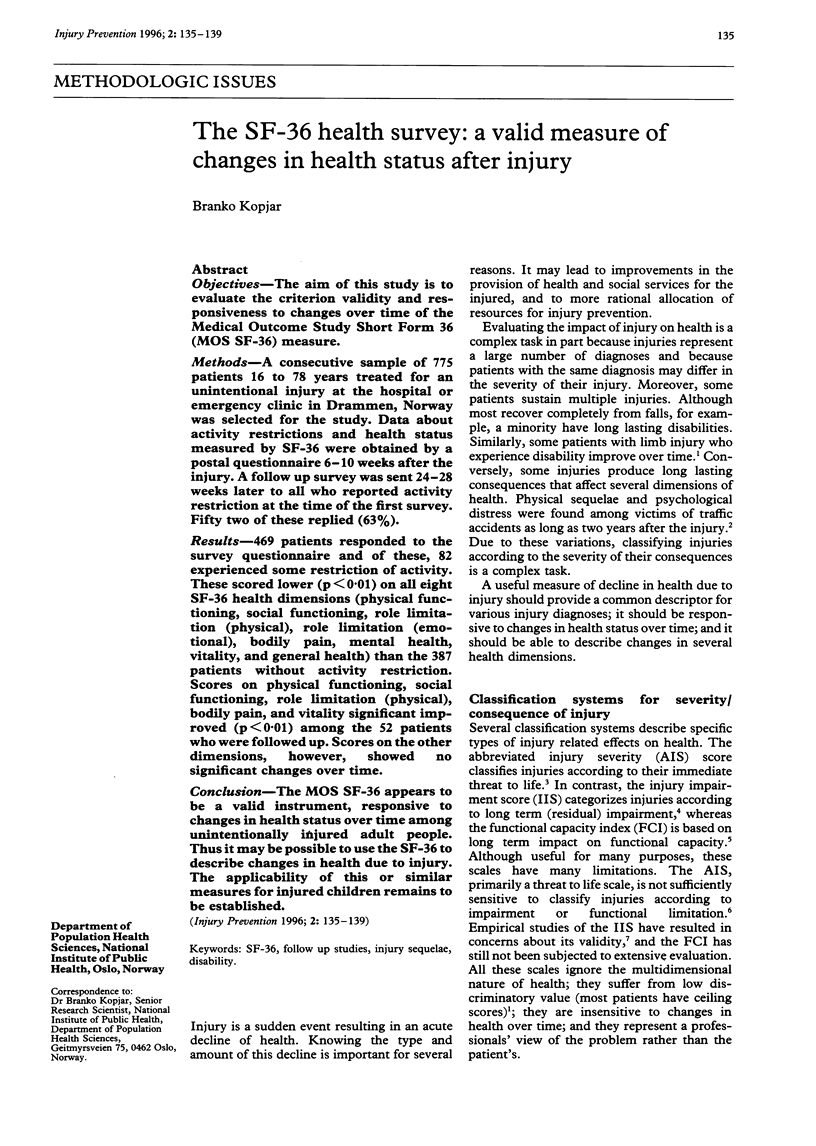
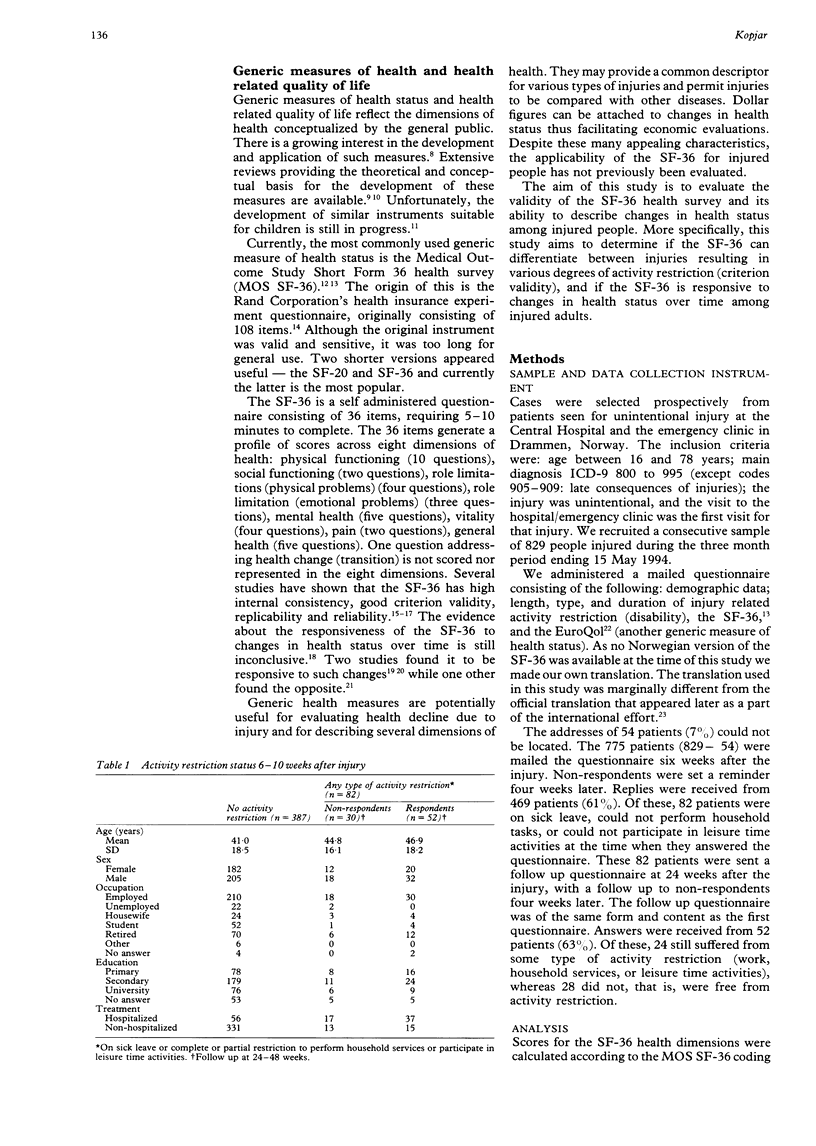
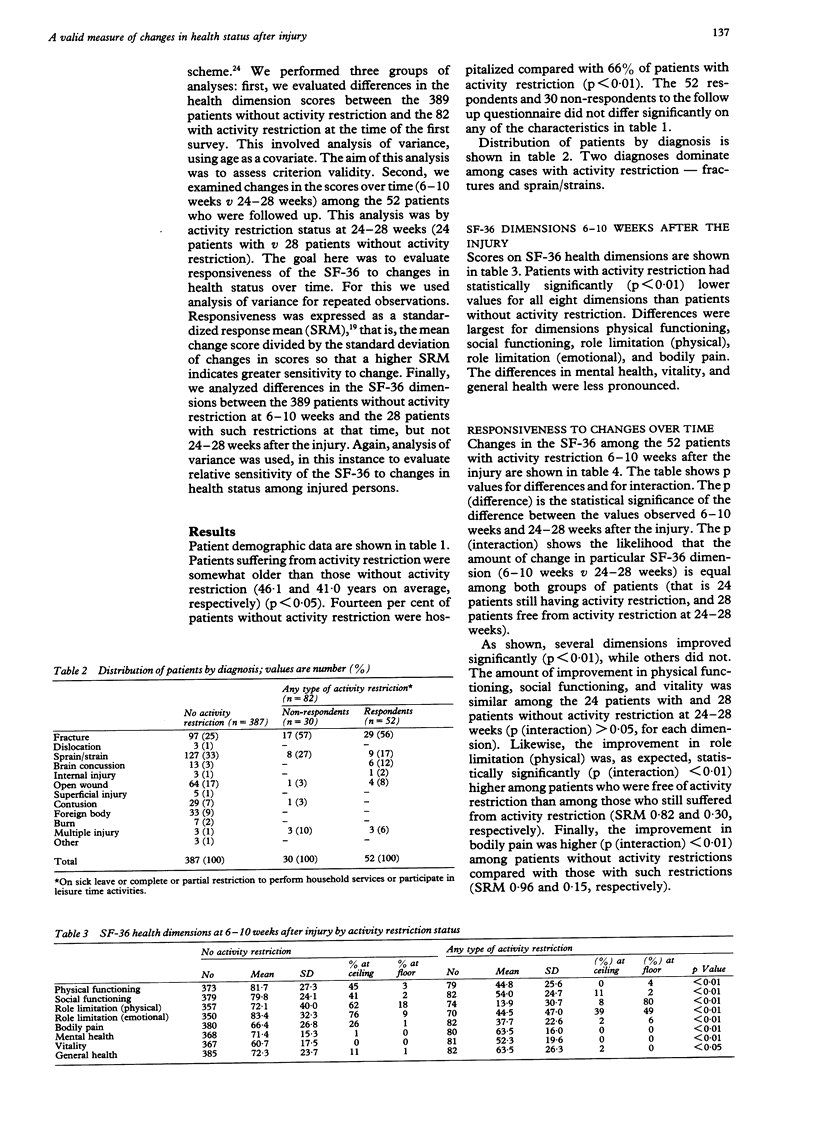
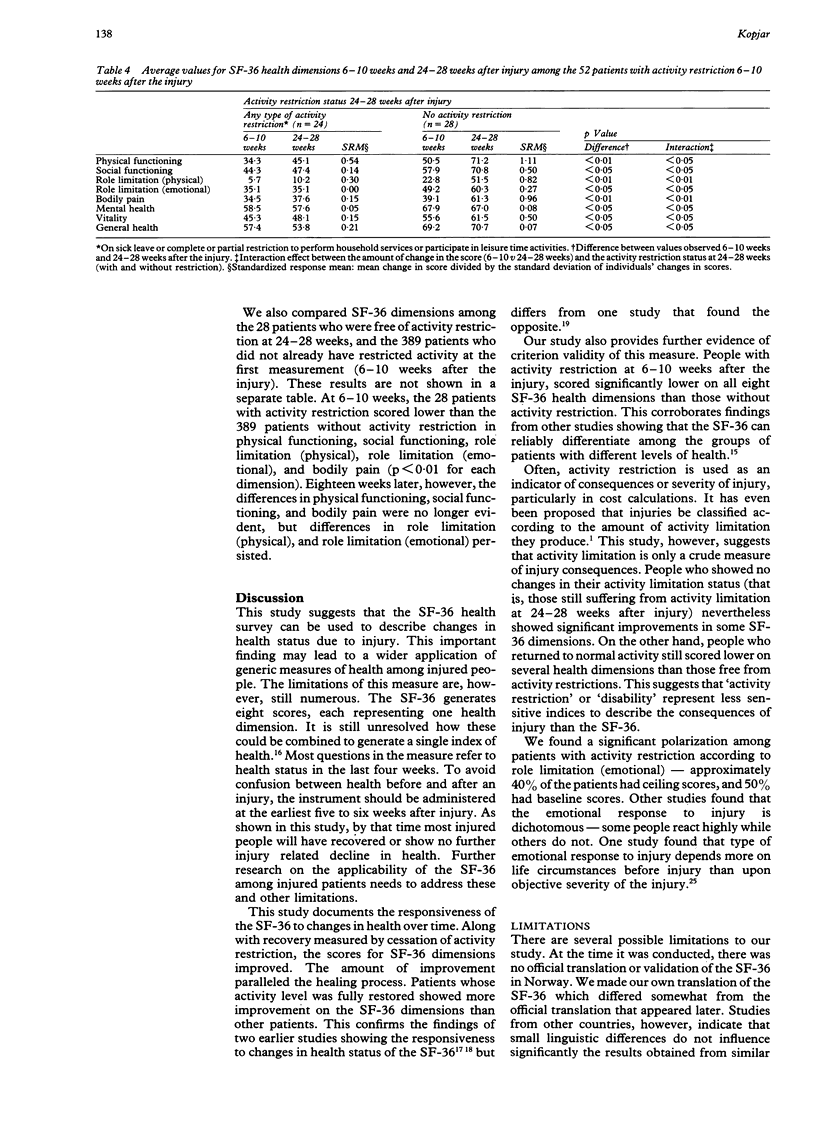
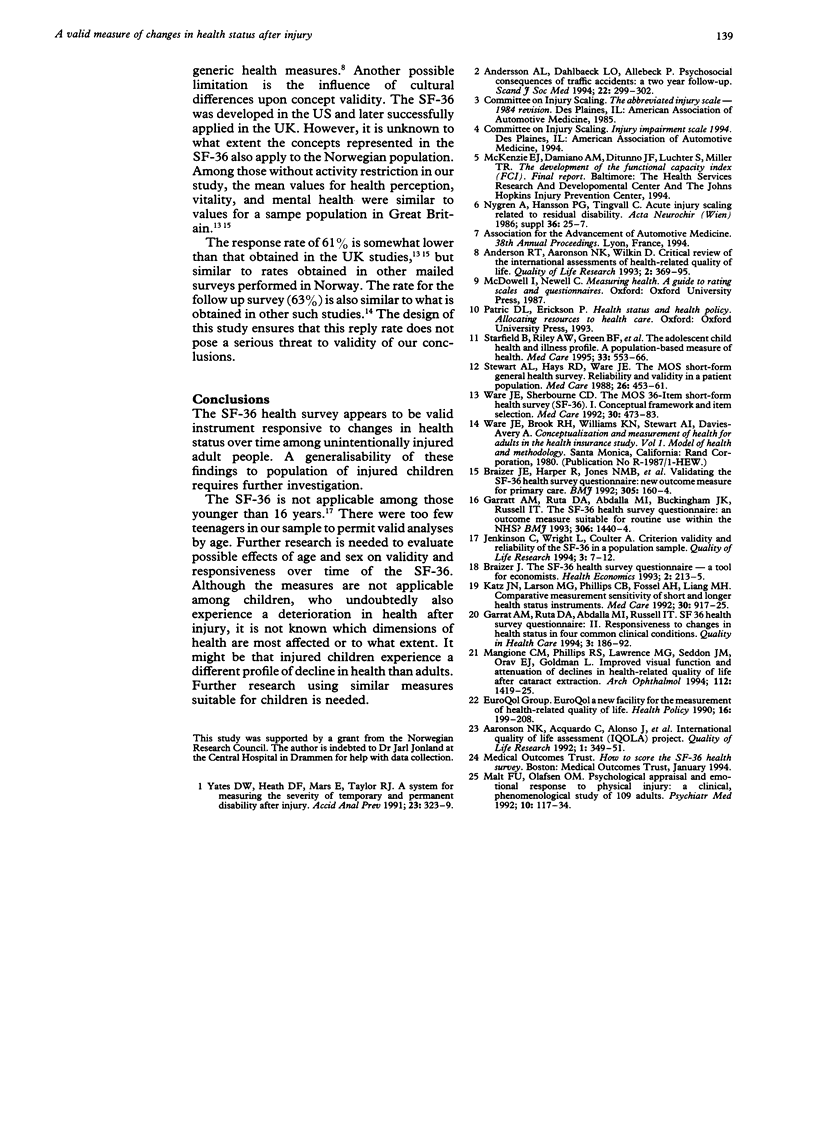
Selected References
These references are in PubMed. This may not be the complete list of references from this article.
- Aaronson N. K., Acquadro C., Alonso J., Apolone G., Bucquet D., Bullinger M., Bungay K., Fukuhara S., Gandek B., Keller S. International Quality of Life Assessment (IQOLA) Project. Qual Life Res. 1992 Oct;1(5):349–351. doi: 10.1007/BF00434949. [DOI] [PubMed] [Google Scholar]
- Anderson R. T., Aaronson N. K., Wilkin D. Critical review of the international assessments of health-related quality of life. Qual Life Res. 1993 Dec;2(6):369–395. doi: 10.1007/BF00422215. [DOI] [PubMed] [Google Scholar]
- Andersson A. L., Dahlbäck L. O., Allebeck P. Psychosocial consequences of traffic accidents: a two year follow-up. Scand J Soc Med. 1994 Dec;22(4):299–302. doi: 10.1177/140349489402200409. [DOI] [PubMed] [Google Scholar]
- Brazier J. E., Harper R., Jones N. M., O'Cathain A., Thomas K. J., Usherwood T., Westlake L. Validating the SF-36 health survey questionnaire: new outcome measure for primary care. BMJ. 1992 Jul 18;305(6846):160–164. doi: 10.1136/bmj.305.6846.160. [DOI] [PMC free article] [PubMed] [Google Scholar]
- Brazier J. The SF-36 health survey questionnaire--a tool for economists. Health Econ. 1993 Oct;2(3):213–215. doi: 10.1002/hec.4730020304. [DOI] [PubMed] [Google Scholar]
- Garratt A. M., Ruta D. A., Abdalla M. I., Buckingham J. K., Russell I. T. The SF36 health survey questionnaire: an outcome measure suitable for routine use within the NHS? BMJ. 1993 May 29;306(6890):1440–1444. doi: 10.1136/bmj.306.6890.1440. [DOI] [PMC free article] [PubMed] [Google Scholar]
- Garratt A. M., Ruta D. A., Abdalla M. I., Russell I. T. SF 36 health survey questionnaire: II. Responsiveness to changes in health status in four common clinical conditions. Qual Health Care. 1994 Dec;3(4):186–192. doi: 10.1136/qshc.3.4.186. [DOI] [PMC free article] [PubMed] [Google Scholar]
- Jenkinson C., Wright L., Coulter A. Criterion validity and reliability of the SF-36 in a population sample. Qual Life Res. 1994 Feb;3(1):7–12. doi: 10.1007/BF00647843. [DOI] [PubMed] [Google Scholar]
- Katz J. N., Larson M. G., Phillips C. B., Fossel A. H., Liang M. H. Comparative measurement sensitivity of short and longer health status instruments. Med Care. 1992 Oct;30(10):917–925. doi: 10.1097/00005650-199210000-00004. [DOI] [PubMed] [Google Scholar]
- Krenz C., Larson E. B., Buchner D. M., Canfield C. G. Characterizing patient dysfunction in Alzheimer's-type dementia. Med Care. 1988 May;26(5):453–461. doi: 10.1097/00005650-198805000-00002. [DOI] [PubMed] [Google Scholar]
- Malt U. F., Olafsen O. M. Psychological appraisal and emotional response to physical injury: a clinical, phenomenological study of 109 adults. Psychiatr Med. 1992;10(3):117–134. [PubMed] [Google Scholar]
- Mangione C. M., Phillips R. S., Lawrence M. G., Seddon J. M., Orav E. J., Goldman L. Improved visual function and attenuation of declines in health-related quality of life after cataract extraction. Arch Ophthalmol. 1994 Nov;112(11):1419–1425. doi: 10.1001/archopht.1994.01090230033017. [DOI] [PubMed] [Google Scholar]
- Starfield B., Riley A. W., Green B. F., Ensminger M. E., Ryan S. A., Kelleher K., Kim-Harris S., Johnston D., Vogel K. The adolescent child health and illness profile. A population-based measure of health. Med Care. 1995 May;33(5):553–566. doi: 10.1097/00005650-199505000-00008. [DOI] [PubMed] [Google Scholar]
- Ware J. E., Jr, Sherbourne C. D. The MOS 36-item short-form health survey (SF-36). I. Conceptual framework and item selection. Med Care. 1992 Jun;30(6):473–483. [PubMed] [Google Scholar]
- Yates D. W., Heath D. F., Mars E., Taylor R. J. A system for measuring the severity of temporary and permanent disability after injury. Accid Anal Prev. 1991 Aug;23(4):323–329. doi: 10.1016/0001-4575(91)90010-3. [DOI] [PubMed] [Google Scholar]


